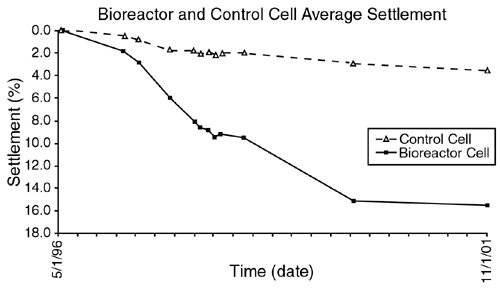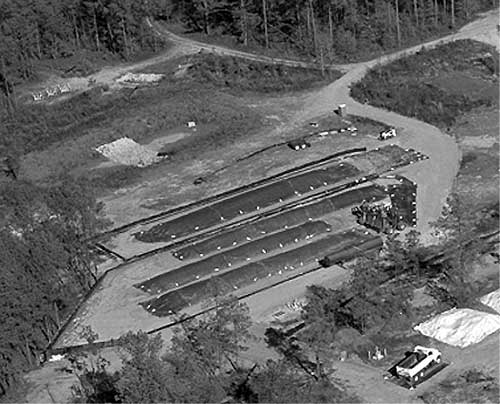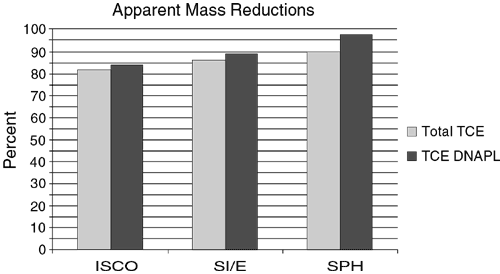Landfill Bioreactor Demonstration Underway in Yolo County, CA
Monitoring results gathered over the past six years show that controlled bioreactor operations in demonstration cells at the municipal landfill in Yolo County, CA, are accelerating anaerobic bioremediation of solid waste. Field data suggest that waste settlement in the bioreactor is occurring approximately 12% faster than in the control cell where conventional landfilling technology is employed. As a result, the demonstration was expanded in 2002 to address large-scale enhanced bioremediation using both anaerobic and aerobic processes.
The Yolo County bioreactor depends upon the controlled circulation of liquid (containing leachate and ground water) throughout the waste material. This process increases the rate of microbial activity, thus decreasing the time required for waste stabilization and decomposition. The technology offers:
- Generation of renewable energy through an accelerated production of recoverable landfill gas;
- Elimination of fugitive emissions of methane gas, a byproduct of anaerobic composting;
- Improved opportunities for treatment and onsite use of leachate; and
- Increased landfill capacity and life.
Due to enhanced waste stabilization, the bioreactor process is anticipated to decrease post-closure maintenance requirements. In addition, the technology provides greater opportunity for landfill “mining,” whereby the composted fraction is removed and used for an alternative daily cover in other landfill modules at the site.
Two 100-ft-square by 40-ft-deep demonstration cells (an enhanced bioreactor cell and a control cell), each containing about 9,000 tons of non-hazardous solid waste, were constructed at the landfill in1995. The base of each cell was constructed with a gravel operations layer over geotextile, a drainage net, a 60-mil HDPE geomembrane composite liner, and a 2-foot layer of compacted clay. In the enhanced cell, a second liner system was added below the primary liner to capture any potential leakage. The depth to the water table in the area ranges seasonally between 4 and 15 ft below ground surface.
To facilitate liquid additions, the waste surface of each cell was constructed with 14 infiltration trenches filled with shredded tires. The trenches are approximately 3 ft wide, 10 ft long, and 5 ft deep. A 3-in perforated PVC pipe was placed vertically at the bottom of each trench, and water was injected through each pipe from a leachate distribution manifold. Liquid is added to the system continuously to maintain a moisture content of 50-65% within the waste.
Two perforated, 4-in vertical wells in each cell collect gas within the waste and through the permeable layer of shredded tires. Gravel surrounds one of the vertical wells, while shredded tires (encased in mesh wire) surround the second. To accommodate the increasing height of waste as it was placed in the demonstration cells, well heights were increased as needed. Both cells are monitored for moisture, temperature, and pressure by 112 sensors wired to a continuous data logger.
Performance data confirm that waste degradation in the bioreactor cell should occur in 5-10 years, in contrast to the 30-100 years required in a conventional landfill. By reducing the overall pollutant load (leachate and landfill gas) early in the life of the landfill, the risk of ground-contamination caused by leachate and landfill gas seepage from an aging, defective, or damaged liner likely has decreased significantly. Recent data indicate that the bioreactor has reached a waste settlement rate of 15.8%, while the control unit reached slightly less than 3.8%. (Figure 1). These results are confirmed by an increase in the total volume of methane gas that was generated; 240% more methane gas was generated by the enhanced cell than by the control cell.

Cumulatively, the enhanced bioreactor has generated 1.54 standard cubic feet of methane per dry pound (scf/lb) of waste, while the control cell has produced 0.64 scf/lb. This production increase suggests more favorable economics for operation of a gas-to-energy conversion facility associated with a bioreactor unit than with a conventional landfill.
In April 2002, the demonstration was expanded to investigate both anaerobic and aerobic decomposition of waste in a 12-acre module containing 220,000 tons of solid waste. The module contains a 9.5-acre anaerobic cell similar to the initial bioreactor, and a 2.5-acre aerobic cell equipped with a vacuum system for drawing air through the landfill. Aerobic operations are expected to degrade significant waste fractions such as ligneous (woody) materials that cannot be degraded anaerobically. Additional information on the technical and regulatory aspects of this "Project XL" initiative is available from the U.S. EPA at www.epa.gov/projectxl. The U.S. Department of Energy and the California Energy Commission has provided funding for this project.
Contributed by Ramin Yazdani, Yolo County/Planning and Public Works Department (530-666-8848 or ramin.yazdani@yolocounty.org)
Enhanced Bioremediation Used for Hazardous Wastes in SRS Soil
In late 2002, the U.S. Department of Energy (DOE) completed treatability studies on the effectiveness of soil amendments for enhancing biodegradation of pesticides and polychlorinated biphenyls (PCBs) in soil at the Savannah River Site (SRS) in Aiken, SC. Amendments consisting of carbon and nitrogen sources such as molasses and animal manure were applied through windrowing techniques. Study results indicate that all contaminants of concern decreased to concentrations below the treatability study goals following 3-6 months of treatment.
The field studies were conducted in treatment areas adjacent to the SRS “CMP Pits” waste site, which contains seven unlined pits that were used until 1979 for the disposal of solvents, pesticides, and lighting components. Due to the detection of solvents in ground water, the pits were excavated, backfilled, and covered by a low-permeability cap in 1984. Surface soil in the adjacent "ballast area," where material was staged during excavation, was found to contain PCB concentrations of 0.005-5.52 mg/kg and pesticide (such as DDT) concentrations of 0.001 to 235 mg/kg.
The presence of the herbicide Silvex precluded incineration as a remedial option for the contaminated soil. As a result, field studies were initiated to evaluate bioremediation enhanced through micronutrient amendments applied by windrow turning equipment (the MicroenfractionatorTM). Aggressive turning of the windrow provided the increased mass transfer and homogenization needed to promote biological reactions.
Surface soil in the treatment areas, which was used in the treatability studies, consists of clayey sand with rocks and pebbles. In previous studies, the soils were found to be highly consolidated, low in pH, nutrient deficient, and low in microbial diversity. Ground water is located 90 ft below ground surface.
Field studies involving cycled aerobic and anaerobic processes were conducted in two treatment areas. Each area contained approximately 600 yd3 of contaminated soil in four 15-by-125-ft windrow treatment cells (Figure 2). One to two equipment passes were made twice each week to mix the windrows and stimulate microbial activity. Anaerobic conditions were established by adding organic material and sufficient water to maintain a moisture content of 18%.

Nutrients were added to the soil to ensure sufficient concentrations of boron, calcium, cobalt, copper, iron potassium, magnesium, manganese, molybdenum, phosphorous, sulfur, and zinc. These additions helped to maintain microbial enhancing conditions, i.e., a temperature of 95-105ºF and a pH of 5-8.5. Study results indicated that treatment beginning with an aerobic process required up to six months for completion, while treatment initiated by an anaerobic process reduced the time to three months.
Aerobic, heterotropic, and pseudomonad plate counts taken one month after treatment indicated that the microbial population within the windrows had increased by three orders of magnitude. Most significantly, study results showed concentration reductions reaching 90% for organochlorine compounds such as DDT. Findings also suggested that the technology was optimized by sustaining a saturated moisture content, cycling aerobic and anaerobic conditions, balancing the carbon/nitrogen ratio by molasses and manure addition, and ensuring thorough blending of the amendments with the contaminated soil.
It is anticipated that enhanced bioremediation will be used to remediate approximately 5,000 yd3 of contaminated soil remaining at the CMP Pits. At an estimated implementation cost of $400 per cubic yard of treated soil, this technology is expected to realize an SRS cost savings of approximately $12.5 million. Additional studies are underway at Clemson University to investigate the mechanisms responsible for anaerobic and aerobic bioremediation occurring at the site. In May 2003, DOE will issue the final treatability study report.
Contributed by Karen Adams, U.S. DOE (803-725-4648 or karen-m.adams@srs.gov) and Ron Beul, Westinghouse (803-952-6451 or ronald.beul@srs.gov)
DNAPL Treatment Demonstration Completed at Cape Canaveral
In 1997, the Interagency DNAPL Consortium initiated side-by-side field evaluations of in-situ chemical oxidation (ISCO), six-phase heating (SPH), and steam injection/extraction (SI/E) for treating trichloroethene (TCE) dense non-aqueous phase liquid (DNAPL) at Cape Canaveral, FL (see July 2001 Ground Water Currents [www.cluin.org]). Final demonstration results indicate that these technologies likely destroyed, captured, or removed 84-97% of the total TCE DNAPL.
The former Cape Canaveral launch site encompasses extensive areas of TCE DNAPL due to the past use of TCE solvent for rocket engine flushing and equipment cleaning. Three 50-by-75-ft treatment cells were constructed at the site in a side-by-side setting that allowed for technology evaluations under a single set of conditions. Apparent mass reduction for the three technologies tested were estimated by analyzing pre- and post-remediation soil cores taken from the saturated zone at depths of 5-45 ft below ground surface.
In the ISCO cell, pre-treatment data indicated a total TCE mass of 6,100 kg with 5,000 kg of TCE present as DNAPL. The mass of total TCE following treatment decreased to 1,100 kg with 800 kg of TCE DNAPL. Spatial data showed good distribution of the oxidant (potassium permanganate) throughout the cell, with the exception of a corner of the cell in the vicinity of a building. Post treatment data indicated that TCE declined sharply in patterns consistent with the oxidant distribution.
Data from the SPH cell indicated a pre-treatment total TCE mass of 11,300 kg with 10,500 kg of TCE DNAPL. The post-treatment total TCE mass in this cell was 1,100 kg with 300 kg TCE DNAPL. Approximately 1,950 kg of TCE vapor and a small amount of TCE degradation products (together accounting for approximately 17% of the total TCE) were recovered aboveground during SPH operations. The amount of TCE remaining in the cell following treatment (approximately 10%), plus that recovered by the vapor extraction system, accounted for approximately 27% of the total TCE estimated to be present before treatment. The unaccounted mass of TCE may be attributed to:
- Erroneous mass estimates for TCE;
- Escape of extracted TCE into the vapor treatment system prior to measurement;
- Escape of TCE vapor emissions into the atmosphere;
- Lateral subsurface migration of TCE beyond the cell boundaries; and/or
- In-situ TCE destruction by hydro-pyrolysis oxidation or other reactions.
Based on thermocouple data and onsite characterization of the three lithologic zones within the demonstration area, vapor and contaminated ground water appeared to migrate laterally beyond the SPH cell. Lateral migration of shallow ground water beyond the cell was found to increase as a result of heavy rainfall during the test. Additionally, displacement of contaminated ground water in the adjacent ISCO cell caused by potassium permanganate injection may have contributed to contaminated ground-water transport from the SPH cell.
Data from the SI/E test cell indicated a pre-treatment total TCE mass of 10,400 kg with 9,300 kg of TCE DNAPL. Following treatment, the total TCE mass had decreased to 1,500 kg with 1,000 kg TCE DNAPL. To avoid contaminant migration beyond the test cell, hydraulic control was implemented by injecting steam in the center of the cell and extracting vapor and ground water from recovery wells located along the cell perimeter. Thermocouple data verified that most of the cell was heated sufficiently to vaporize the TCE, with minimal temperature increases beyond the cell boundary. More than 3,962,000 gallons (11 pore volumes) of ground water were pumped from the recovery wells during the test. The use of recovery wells positioned along the cell perimeter, where ground water from outside of the cell also was captured, contributed to the high volume of water pumped from the wells.
Apparent mass reductions in total TCE mass and TCE DNAPL were determined for the three technologies tested (Figure 3). Analysis indicated an SI/E cost of $134, SPH cost of $64, and ISCO cost of $234 for each kg of TCE removed or destroyed. Costs per cubic meter of material treated were estimated at $152 for SPH, $265 for ISCO, and $283 for SI/E. It is anticipated that these costs may be lowered through additional system design optimization and in large-scale applications benefiting from economy of scale. The Interagency DNAPL Consortium will issue a comprehensive report on this demonstration in 2004. Additional information about the consortium’s activities is available at www.getf.org/dnapl.

Contributed by Thomas Holdsworth, U.S. EPA (513-569-7675 or holdsworth.thomas@epa.gov); Jackie Quinn, NASA (321-867-8410); Thomas Early, Oak Ridge National Laboratory (865-576-2103); and Laymon Gray, Florida State University (850-644-5516)
Chemical Amendment Reduces Metal Contamination at Former Fertilizer Facility
Remediation efforts at a former fertilizer-manufacturing site illustrate the challenges posed by metal contamination in saturated soil. Several technologies were evaluated over the past three years at the 2.5-acre Former Ashepoo Phosphate/Fertilizer Works site near Charleston, SC. Treatment technologies that were considered sequentially and field-tested in various degrees included: (1) a permeable reactive barrier (PRB); (2) in-situ, high-pressure injection of chemical amendment; (3) in-situ, low-pressure chemical injection; and (4) solidification/stablization. Significant concentration reductions for the primary metals of concern (arsenic and lead) in soil and ground water were achieved only through a solidification/stabilization involving excavation of contaminated soil, mechanical mixing with amendment, and backfilling with treated soil.
The Ashepoo site is located in lowlands between the Ashley and Cooper Rivers. It is underlain by 1-8 feet of low-strength fill and debris above 14-28 ft of loose permeable sand resting on low-permeability clay; the water table is approximately 4 ft below ground surface. The fertilizer manufacturing process used at Ashepoo between the mid 1800s and the 1960s involved dissolution of phosphate rock (containing trace levels of naturally-occurring arsenic) with sulfuric acid in lead-lined vats. Dissolved lead and arsenic were found at concentrations up to 18 mg/L and 220 mg/L, respectively. Additionally, the pH of ground water was as low as 0.4 standard units, which is a common result of fertilizer manufacturing practices used in the past.
In 1999, a PRB was selected as the preferred remedy for the site. Pre-design investigations, however, found the remedy was not appropriate due to unfavorable hydrogeologic conditions. Field tests to evaluate the potential of in-situ stabilization/solidification by chemical amendment began in 2000. Remediation goals for lead and arsenic stabilization required that concentrations of arsenic and lead in the leachate of unsaturated soil be less than 5.0 mg/L. Remediation goals for arsenic and lead concentrations in ground water at a point downgradient of the contaminant source area were less than 0.050 mg/L and 0.015 mg/L, respectively. Approximately 1,500 yd3 of unsaturated soil and 60,000 yd3 of aquifer required treatment.
The amendment selected for use at Ashepoo (EnviroBlend®) is based on pH neutralization and buffering, reduction/oxidation, lead-complexation, and arsenic adsorption/co-precipitation. Excess acid neutralization capacity was added to the process to provide for long-term pH control of the treated soil mass. Pilot tests were conducted to assess technologies for introducing the chemicals to the aquifer.
The first injection test used pneumatic fracturing and liquid atomized injection of slurried chemicals under high pressures and low liquid flow rates. The low strength of the backfill and soil and the anthropomorphic preferential flow paths, however, caused injectate to discharge at the ground surface. The second pilot test involved hydraulic fracturing and direct, low-pressure injection of slurry at a rate of 10-15 gpm. This approach improved delivery of the slurry to soil but the in-situ distribution of chemicals was insufficiently uniform.
Successful treatment results finally were achieved through excavation of unsaturated soil and direct mechanical mixing with dry chemicals using a specialized Lang rotary mixer. Full-scale application of this technology began in February 2002 and was completed nine months later.
Quality control of the aquifer soil treatment was monitored through a porewater screening process followed by ground-water sampling from 20 temporary wells. Based on these results, six monitoring wells were placed in the aquifer at locations downgradient of the treated backfill. Post-treatment median arsenic and lead concentrations in ground water from the six wells were 92 and 98% lower, respectively, than pre-treatment median concentrations. The maximum post-treatment lead concentration was 0.028 mg/L, with approximately 70% of the samples meeting the lead concentration target. The maximum post-treatment arsenic concentration was 0.68 mg/L, with about 25% of the samples meeting the arsenic target.
Geochemical evaluations, including modeling, suggest that arsenic concentrations may decrease further as carbon dioxide produced by treatment reactions degasses from the aquifer. Monitoring of the treated aquifer and the downgradient compliance point will continue through 2008.
Contributed by Craig Zeller, U.S. EPA/Region 4 (404-562-8827 or zeller.craig@epa.gov), Christina Straib, URS Corp (713-914-6502 or christina.staib@urscorp.com), and Bernd Rehm, RMT Inc (608-662-5108 or bernd.rehm@rmtinc.com)





